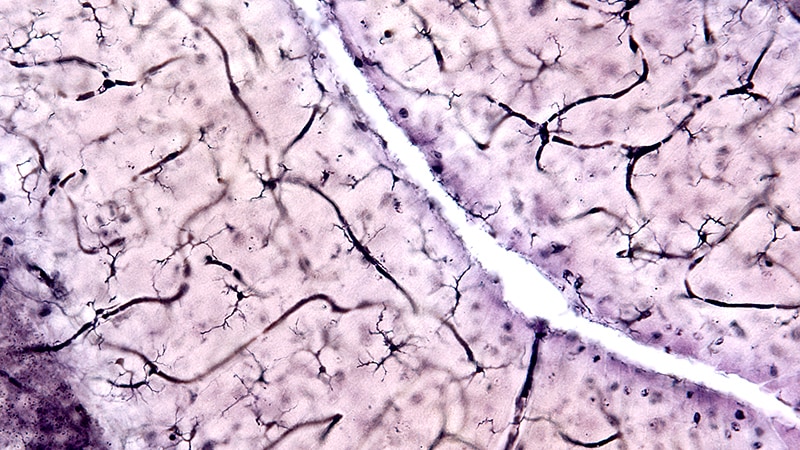Genetic Alterations Lead to Diverse Cellular Effects in AD
The study covered in this summary was published in medRxiv.org as a preprint and has not yet been peer reviewed.
Key Takeaways
-
A single Alzheimer disease (AD) risk variant gene alteration can affect the transcriptional landscape of multiple brain cell types.
-
Mutations in autosomal dominant AD genes (APP and PSEN1) influenced the profiles of neurons and glia differently in comparison to patients with spontaneous AD and to control persons.
-
Variants in TREM2 shifted microglial and oligodendrocytic profiles, and an MS4A variant altered the activated microglia profile.
-
Each of these changes has the potential to modify clinical manifestations and affect the pathologic progression of AD.
Why This Matters
-
Genetic studies provide understanding of the main AD molecular events for both the amyloid hypothesis and neuroimmune modulation. Yet, the functional genes, downstream transcriptional ramifications, and cell type–specific effects of many genetic loci are poorly understood.
-
Gaining an understanding of expression profiles at the cellular level in a wide array of genetic alterations in individuals can uncover cell-specific effects of AD risk genes and can help to uncover potential therapeutic targets.
-
The study highlighted the use of genetic and single-cell molecular data to understand the heterogeneity of pathways, biological processes, and cell types modulated by genetic risk factors for AD.
-
The study helped to establish that genetic screening for drug trials and selecting optimal treatment programs is helpful for patients with AD.
Study Design
-
Brains were selected from the Dominantly Inherited Alzheimer Network (DIAN) and Charles F. and Joanne Knight Alzheimer Disease Research Center (Knight ADRC) biobanks.
-
Single-nucleus RNA-sequencing of 294,114 human parietal cortex nuclei from 67 individuals who were carriers of AD pathogenic mutations (APP, PSEN1, PSEN2), risk variants in TREM2, or resilience variants of the MS4A cluster was completed to investigate their cellular and transcriptional profiles in order to elucidate their role in AD pathogenesis.
-
Deep subclustered analysis per cell type and state was conducted for differentially expressed genes. Differences in cell-type composition associated with autosomal dominant AD, APOEε4, TREM2, and MS4A carriers and differentially expressed genes were analyzed.
-
Results of cell-state differential expression were used to link genes in AD genome-wide association studies to their functional cell types.
Key Results
-
Within the cohort of samples from 67 patients with AD, 41 samples carried the minor allele (A) for a single-nucleotide polymorphism in the MS4A gene cluster, and 24 samples carried the APOEε4 allele.
-
Every cell type analyzed exhibited cell states enriched with autosomal-dominant AD carriers. Autosomal-dominant AD brains exhibited unique transcriptional states in all cell types. Some had altered cellular architecture as well.
-
Carriers of TREM2 variants were enriched for specific microglia and oligodendrocyte subpopulations.
-
A microglia state expressing activation markers enriched for homozygous carriers of the MS4A resilient variant was observed, with upregulation of proinflammatory genes and other genes related to cytokine signaling.
-
The number of APOEε4-high neurons increased before clinical onset of AD and decreased during disease progression. A correlation between APOE expression and MHC-1 expression was also observed predominantly in inhibitory neurons.
-
Some genes implicated in AD, including PLCG2 and SORL1, were expressed in a broader range of cell types than have previously been reported.
Limitations
-
Limitations were not discussed in the article.
Disclosures
-
The study was funded by the US National Institute of Health, the Hope Center, the Archer Foundation, the Alzheimer Association, and the Chan Zuckerberg Initiative.
-
One co-author receives research support from Biogen, EISAI, Alector, and Parabon and is a member of the advisory board of Vivid genetics, Halia Therapeutics, and ADx Healthcare.
This is a summary of a preprint research study, “A Landscape of the Genetic and Cellular Heterogeneity in Alzheimer Disease,” written by researchers at the Washington University School of Medicine, Department of Psychiatry, Department of Neurology, St. Louis, Missouri, the University of Southern California, Keck School of Medicine, Alzheimer’s Disease Research Center, Los Angeles, California, Neuroscience Research Australia, Sydney, NSW, Australia, publiushed on medRxiv, and provided to you by Medscape. This study has not yet been peer reviewed. The full text of the study can be found on medRxiv.org.
For more news, follow Medscape on Facebook, Twitter, Instagram, and YouTube.
Source: Read Full Article
